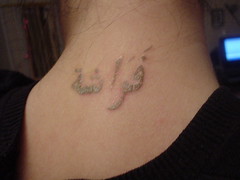
This is the latest view, and farashah is Arabic for butterfly. Compare with kelebek, bilinwal, pillangao, papillon, and farfalla, all of which sound rather different from butterfly, which, etymologically speaking comes from the Old English buttorfleoge (butter + fly). Why? Possibly because of the ancient belief that insects steal butter or else simply because some common varieties are butter-coloured. Well I never!
And back to the sign-bearing body. Here'™s Bourdieu on the subject:
Strictly biological differences are underlined and symbolically accentuated by differences in bearing, differences in gesture, posture and behaviour which express a whole relationship to the social world. To these are added all the deliberate modifications of appearance, especially by the use of set marks - cosmetic (hairstyle, make-up, beard, moustache, whiskers etc) or vestimentary -which because they depend on the economic and cultural means that can be invested in them, function as social markers deriving their meaning and value from their position in the system of distinctive signs which they constitute and which is itself homologous with the system of social positions.
Distinction p.192
So that may help us in the reading of skin art in general or our take on the particular instance of the farashah mark.
1 comment:
Hello!
I have just found your website great
2006 gay memorial day
all natural girl fucking
ameture black porno vids
anne hathaway nude stills
asian lesbian xxx clips
best admin
David Schreiber
Post a Comment